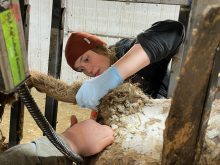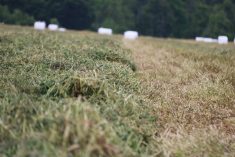For the Canadian beef industry, 1998 will be known as the year of the unexpected.
The industry is into its third year of herd reduction with high numbers of females still going to market and adding to the record amount of beef.
“In the last three years we have had record heifer placements and in 1998 we were up to a level we have never seen before,”said Anne Dunford, an analyst for Canfax.
“We’re going to watch the heifer side of the equation because we make the bottom of the cattle cycle to be 2000 or 2001,” she told the recent Alberta Cattle Feeders Association meeting in Calgary.
Read Also

Feds propose overhaul of chronic wasting disease control program
Chronic Wasting disease control program getting updated by Canadian Food Inspection Agency with feedback encouraged from producers.
In 1998, 87 percent of the heifers were killed; the 15-year average is 65 percent. Heifers will be kept at home for breeding only when calf prices get stronger, she said.
Inventory reports last week from Agriculture Canada had no big surprises. The national beef herd stands at 12.8 million head, down from the 1996 high of 13.4 million for the same period.
Alberta continues as the country’s beef giant. Alberta numbers dropped two percent to 1.8 million head in 1996 and Saskatchewan followed at just over one million beef cows.
Alberta stands number six in North America in terms of cow populations, behind Texas, Missouri, Nebraska, Oklahoma and South Dakota. Saskatchewan holds 10th place.
The United States is also down one percent at 34 million head of beef cows, said Duane Lenz, an analyst with Cattlefax, the American market tracking organization. He joined Dunford in a joint analysis of the two countries’ cattle cycles, which are tracking closely.
Alberta’s production of fed cattle continues to expand. Last year 2.4 million animals were finished for slaughter, up 10 percent from 1997.
Even though the capacity is there to take additional cattle, there should be a slowdown because there will be fewer calves born next year.
In 1998, Alberta led the way finishing 69 percent of the available cattle. Ontario had 18 percent, Saskatchewan and Manitoba had 10 percent each, Quebec was at two percent and the remainder fed one percent. However, beef overproduction remains an issue with seven percent more meat produced than expected at 3.4 billion pounds.
Carcass weights attained record levels in 1998 when the average steer dressed out at 800 lb. That added an extra 95 million lb. of beef to an already tight market where demand is static.
Annually since 1985, steers have gained 8.5 lb. over the previous year. For the first two months of 1999, carcasses are six lb. lighter than a year ago.
“If you want to watch one thing this year, watch the carcass weights on a week-to-week basis,” said Dunford.
There was increased tonnage of pork as well. Producers will likely generate about the same in 1999, which will have a competitive effect on the price of beef in the store.
Hog inventory reached 12.5 million head, down 1.1 percent from October but up 3.9 percent over January 1998.
Chicken production slowed somewhat with only a one percent increase compared to about five percent growth in past years.
On the export side, Canada shipped more than half of what it produces on the hoof or in a box. It shipped about $2.6 billion worth of live cattle and beef in 1998 and exported 38 percent more than it imported. While about 90 percent of the exports go to the U.S., sales to Japan picked up by 15 percent.















